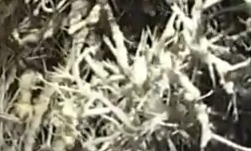
August Editorial
The El Soplao helictites

August Editorial
The El Soplao helictites
|
Cantabria, on the north coast of Spain is a geological treasure-house. What makes this small region (5,321 km2) particularly interesting is that it contains a huge network of caves. According the the latest survey (July 2010), there are approximately 307 km of caves under Cantabria - and that’s just the known passages. A further 3 to 5 km of caves are discovered every year. That’s more than 6,500 caves and some of these, such as El Soplao are geologically unique.
|
El Soplao is situated about 60 km southwest of Santander, the capital of Cantabria, inside a mountain which rises above the village of Rabago. El Soplao is best known for eccentric crystallographic formations called helictites. Although helictites occur in other caves, they are not as abundant, or as fine quality, or as spectacular as the El Soplao helicites. |
A helictite is a speleothem found in limestone caves. The word ‘speleotherm’ comes from Greek, and it means ‘cave deposit’ - the deposit being the minerals left behind as water seeps through the rock. (Sometimes speleotherms are known as ‘cave formations’.) Most people know of the common speleothems, which are stalagmites and stalactites. But while stalagmites grow upward, and stalactites grow down, helictites grow sideways. Essentially a helictite is a stalactite that has a central canal with twig-like or spiral projections coming off the side.
As the growths extend from the vertical stem they create amazing shapes. The small and very delicate projections bend and twist as they defy gravity. The created shapes have been described as ribbons, rods, butterflies or curly-fries depending what the individual imagination sees. Helictites are very fragile and break easily when touched.
No-one is absolutely sure how the helictites form but the most accepted explanation is that the capillary forces which act on water droplets are sufficient to allow changes in the direction of growth. Helictites are made either of calcite or aragonite.
Calcite helictites usually have vermicular (worm-shaped) forms, without sharp edges. They are white because they are pure calcium carbonate. The projections are usually not completely hollow, but have a fine interior capillary which ensures that the calcic solution reaches the end. The aragonite helictites are chemically identical to the calcite forms but because the crystal structure of aragonite is different, aragonite helictites are usually much more geometrical. So whereas calcite helictites develop unusual curved patterns, those of aragonite are thin, transparent and needle-like.
Helictites grow extremely slowly. An experimental area was chosen in El Soplao cave to monitor new helictite growth. This area has now been monitored for fifteen years and so far there is no sign of new growth, which means that the existing helicites are very old indeed.
However, it is difficult to date helictites. The El Soplao cave probably formed at the same time as the mountain which contains it; and scientists estimate that the mountain is around 100 million years old. But speleothems grow at an unpredictable rate so the closest guess is that the El Soplao formations are between 1 million to 50,000 years old.
One thing that makes El Soplao unique is the density of helictites in the cave. It is estimated that there are about 4000 formations in every square metre. Most helictites are in the western part of the cave, where there are no natural entrances. They grow on the floor, the walls, the cave roof, on top of old stalactites and stalagmites, and even on the shields. (A shield is a thin double disk sandwiched only by a capillary formed by calcite-rich water which seeps through the cracks in a cave wall.)
El Soplao was discovered in 1908 by miners working the La Florida mine for zinc and lead. Today the site is a geological work in progress with some 60 scientists working there. The cave has been converted into museum and was opened to public in 2003. The video below will give you a glimpse of the splendour of El Soplao.
| _______________________________ | ||||
| Home | | | Shopping | | | Database |
© Biscuit Software 2004-2015
All rights reserved